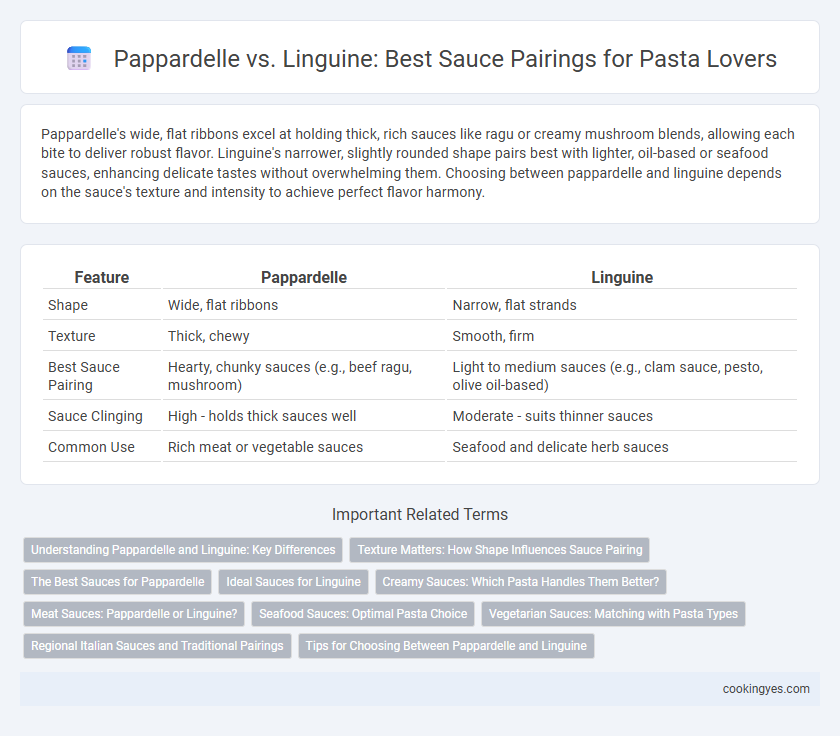Pappardelle's wide, flat ribbons excel at holding thick, rich sauces like ragu or creamy mushroom blends, allowing each bite to deliver robust flavor. Linguine's narrower, slightly rounded shape pairs best with lighter, oil-based or seafood sauces, enhancing delicate tastes without overwhelming them. Choosing between pappardelle and linguine depends on the sauce's texture and intensity to achieve perfect flavor harmony.
Table of Comparison
| Feature | Pappardelle | Linguine |
|---|---|---|
| Shape | Wide, flat ribbons | Narrow, flat strands |
| Texture | Thick, chewy | Smooth, firm |
| Best Sauce Pairing | Hearty, chunky sauces (e.g., beef ragu, mushroom) | Light to medium sauces (e.g., clam sauce, pesto, olive oil-based) |
| Sauce Clinging | High - holds thick sauces well | Moderate - suits thinner sauces |
| Common Use | Rich meat or vegetable sauces | Seafood and delicate herb sauces |
Understanding Pappardelle and Linguine: Key Differences
Pappardelle features wide, flat ribbons ideal for hearty, rich sauces like ragu or mushroom cream, allowing thick sauces to cling effectively. Linguine has a narrower, slightly elliptical shape that pairs well with lighter sauces such as seafood or pesto, offering a balanced sauce-to-pasta ratio. Choosing between pappardelle and linguine depends on sauce texture and desired flavor intensity for optimal pasta dish harmony.
Texture Matters: How Shape Influences Sauce Pairing
Pappardelle's broad, flat ribbons provide a hearty surface that holds thick, chunky sauces like ragu or mushroom-based mixtures well, enhancing every bite with rich texture. Linguine's slender, slightly elliptical shape excels in coating lighter sauces such as pesto, clam sauce, or seafood-based blends, allowing the delicate flavors to cling without overpowering. Texture plays a crucial role in sauce pairing, as thicker pastas like pappardelle support robust sauces, while thinner linguine complements more fluid, subtle dressings.
The Best Sauces for Pappardelle
Pappardelle, a broad and flat pasta, pairs best with rich, hearty sauces like Bolognese, wild boar ragu, or creamy mushroom sauce, as its wide surface captures the sauce effectively. Unlike linguine, which suits lighter, olive oil-based or seafood sauces, pappardelle's texture complements thick, meaty, and chunky sauces, enhancing the overall flavor experience. The ridges and width of pappardelle allow it to hold onto sauces with substantial body, making it ideal for slow-cooked, robust recipes.
Ideal Sauces for Linguine
Linguine pairs perfectly with light to medium-bodied sauces such as pesto, clam sauce, and garlic-infused olive oil due to its narrow, flat shape that holds delicate flavors well. The pasta's texture complements seafood-based sauces and fresh herb blends, enhancing the overall dish without overpowering the ingredients. When choosing linguine, opt for sauces that emphasize freshness and subtlety to maximize its tender bite and thin profile.
Creamy Sauces: Which Pasta Handles Them Better?
Pappardelle's broad, flat ribbons hold creamy sauces exceptionally well, creating a rich and velvety texture in every bite. Linguine, with its narrow, slightly rounded shape, offers a lighter coating that works better for thinner, less dense creamy sauces. For thick, hearty cream sauces like Alfredo or mushroom cream, pappardelle provides superior sauce adherence and flavor integration.
Meat Sauces: Pappardelle or Linguine?
Pappardelle's wide, flat shape is ideal for thick, hearty meat sauces like ragu or Bolognese, as it holds chunky chunks and rich flavors effectively. Linguine's thinner, narrower strands pair better with lighter meat sauces or seafood-based options, allowing delicate flavors to shine without overwhelming the pasta. For robust meat sauces demanding a sturdy base, pappardelle is the optimal choice, ensuring a balanced, satisfying dish.
Seafood Sauces: Optimal Pasta Choice
Pappardelle's broad, flat surface excels at holding chunky seafood sauces like clam ragu or seafood Bolognese, enhancing each bite with rich, textured flavor. Linguine, thinner and slightly curved, pairs best with lighter seafood sauces such as garlic white wine or lemon butter clam sauce, allowing delicate flavors to shine without overpowering the pasta. Choosing between pappardelle and linguine significantly impacts the balance and mouthfeel of seafood dishes, optimizing taste and texture harmony.
Vegetarian Sauces: Matching with Pasta Types
Pappardelle's broad, flat shape holds hearty vegetarian sauces like mushroom ragu or roasted vegetable medleys, enhancing the sauce's texture and flavor absorption. Linguine's thin, round form pairs best with lighter vegetarian sauces such as pesto, olive oil-based dressings, or fresh tomato and herb blends, allowing the delicate flavors to shine without overpowering the pasta. Selecting the right pasta shape ensures balanced sauce distribution and a harmonious vegetarian dish.
Regional Italian Sauces and Traditional Pairings
Pappardelle, wide and flat, is traditionally paired with rich, hearty Tuscan sauces such as wild boar ragu or hearty mushroom-based ragu, which cling well to its broad surface. Linguine, thinner and more delicate, excels with Ligurian coastal sauces like pesto alla genovese or seafood ragu, where the strands capture fine herb and seafood flavors. Both pastas showcase regional authenticity by complementing the texture and intensity of local Italian sauces.
Tips for Choosing Between Pappardelle and Linguine
Pappardelle's wide, flat shape is ideal for thick, hearty sauces like ragu or mushroom cream due to its ability to hold chunky ingredients. Linguine's narrow, slightly flattened strands work best with lighter sauces such as pesto, clam, or tomato-based, allowing the flavors to cling without overpowering the pasta. When choosing between pappardelle and linguine, consider the sauce's texture and weight to ensure the pasta complements and enhances the overall dish.
Pappardelle vs linguine for sauce pairing Infographic

 cookingyes.com
cookingyes.com